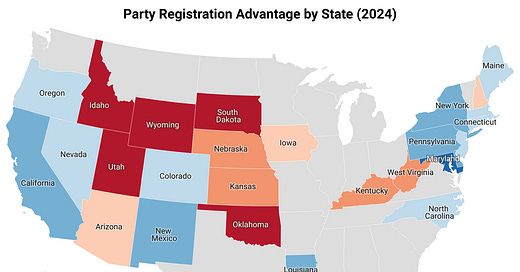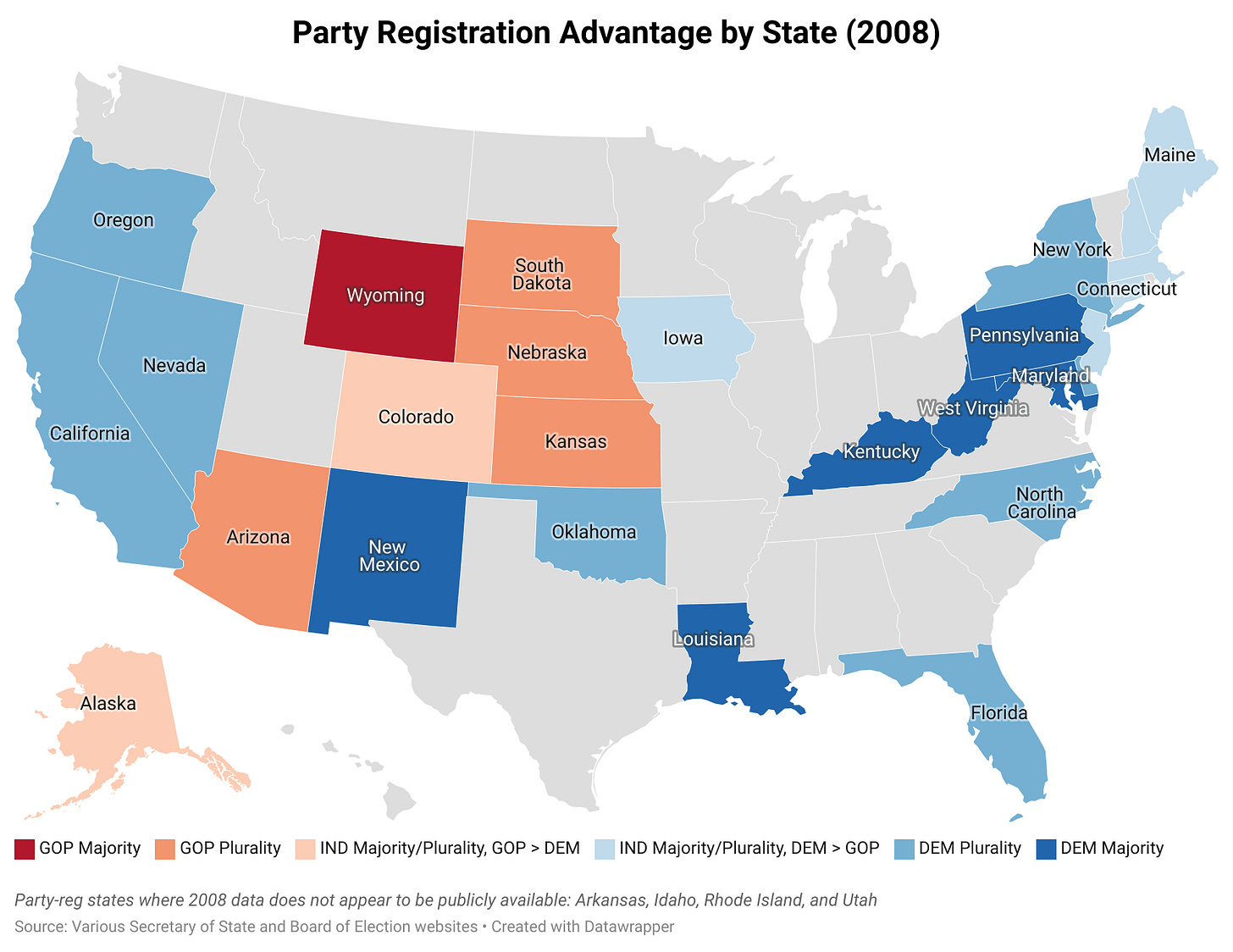The Democrats’ Voter Registration Blues
How the party has lost ground to Republicans in adding new voters to their ranks.
As the Democrats work to make sense of their recent electoral struggles, one trendline worth weighing is the decline in the number of Americans who are actually registered with the party. Residents in more than half (31) of states and Washington, DC, declare a party affiliation when they register to vote, which gives us another way of gauging how popular the two major parties are—or aren’t. (Though it’s worth noting that having a formal affiliation with a party does not necessarily mean a voter will reliably support that party’s candidates.)
During Barack Obama’s first presidential run, his campaign employed a rigorous voter-registration program, which helped boost the Democrats’ ranks all across the country. Ahead of the 2008 election, the party held an advantage over Republicans in 21 states while the GOP had the edge in just seven.1
So it wasn’t that long ago that Democrats had a clear upper hand in registrations. But fast forward to today and things are much more evenly split. As of 2024, more voters registered as Democratic than Republican in 17 states while the reverse was true in 14 states. Much of this development is due to voters—especially Republicans—belatedly beginning to update their partisan affiliation status to reflect their voting behavior. Many voters raised in ancestrally Democratic states often grew up with that party identification, even as they themselves may have been more ideologically conservative or typically voted Republican.
The jarring difference between the two maps in favor of Republicans highlights how alarming these trends have been for the Democrats in recent years. Consider some observations from this period:
Democrats only surpassed Republicans in the voter rolls in one state: Colorado. However, this isn’t saying much, as a majority (51.4 percent) of the state’s voters were registered independents as of 2024. Meanwhile, Republicans surpassed Democrats in six states. Three of these—Oklahoma, Kentucky, and West Virginia—have long voted Republican at the top of the ticket, and registrations now seem to be catching up to that fact. But the other three—Florida, Iowa, and New Hampshire—are places that have been fairly competitive over the past couple of decades but where Democrats have struggled more as of late.
Democrats went from having a majority of the registrations in six states down to just one (Maryland). Republicans went from having a majority of the registrations in just one state (Wyoming) up to a least three.2
Democrats lost their plurality advantage to independents in three states (Oregon, North Carolina, and Nevada) and watched as their majorities fell to pluralities in two more (New Mexico and Pennsylvania). Republicans only lost their plurality advantage to independents in just one state (Arizona).
Overall, between 2008 and 2024, just four states trended more Democratic than Republican in party registration: California, Colorado, Delaware, and New York. In 22 others where we have data, Republicans had more success. This paints a stark picture of how the two parties have fared during this period (though, again, it’s important to remember that in several states, independents are now a plurality or majority).
But it’s not the party’s rapidly dwindling status in Oklahoma or Kentucky or Louisiana that keeps Democratic strategists up at night. It’s the swing states that will decide who wins the presidency or control other statewide offices—and it’s here that we begin to see the seeds of the party’s problem in the Electoral College and the Senate.
The first real warning sign of the party’s registration woes in a swing state came from Florida. For decades, more Floridians registered as Democrats than Republicans, and Obama’s campaign helped the party expand that margin to a high of roughly six points in 2008. However, following that election, the gap began to steadily and inexorably close, as the number of registered Republicans grew at a rapid clip. Then, in 2020, conservatives from around the country began flocking to the anti-COVID-lockdown haven built by Governor Ron DeSantis. This, plus the subsequent nose dive in Democratic registrations, helped Republicans finally overtake them.3
The change is astonishing: as of 2024, the GOP already had a registration advantage of 1.1 million people. Their registration share margin over the Democrats (7.8 points) was larger than any margin that Team Blue ever enjoyed during its dominant, decades-long reign atop the voter rolls. This has coincided with Florida’s drift away from its historical presidential battleground status: Trump carried it by 13.1 points last year, the widest margin for any presidential nominee since 1988.
Florida may be a canary in the coal mine when it comes to Democrats’ problems in swing states, as the same registration trendline has been visible in three others for some time now: Nevada, North Carolina, and the all-important Pennsylvania. In all three, the Republicans have been eating into their advantage for years, and if the current trends continue unabated, they will likely flip it in the GOP’s favor before the next presidential election—if not the 2026 midterms.4
Arizona is also a perennial battleground, though its history is a little different than that of the previous three states. Republicans have long had a small but steady registration edge here. However, Democrats hoped that was beginning to change during the Trump era, and that as Trump was gaining ground in the Rust Belt, their gains in the Sun Belt might be indicative of where their future electorate was. And indeed, it looked for a while like Arizona might offer a silver lining in this otherwise relatively bleak national picture, as Democrats chipped away at Republicans’ edge there in 2016 and again in 2020. But as of 2024, the GOP not only turned the tide—they grew their advantage to 5.8 points, the widest margin for either party this century.
So the overall picture today isn’t as rosy as Democrats may have hoped, but it is entirely within the party’s power to change that fact. As they work through difficult internal debates to figure out their best path forward, it may be time to just get back to the basics. In the absence of a broader, consensus strategy for regaining power, working to add people back to their rolls might be a good place to start.
In four party-registration states—Arkansas, Idaho, Rhode Island, and Utah—this data was not readily available for 2008.
In two others, Utah and Idaho, Republicans had a majority of the registrations in 2024, but there wasn’t publicly available data for them in 2008 to make comparisons.
As Liberal Patriot’s Nate Moore noted earlier this week, the GOP was also the beneficiary of a greater number of party-switchers than the Democrats were.
In fact, in Nevada, it already has.








The Democrats will not be making a comeback anytime soon, for they are no longer liberals. They don't stand for all the values of liberalism mainly being; personal choice. They are the party of conformists and authoritarians. Joe Biden took civil rights away from women and mandated speech. This is not Democracy or liberalism. The party of censorship is dead and no matter how much outrage they display, they have no power. All the true liberals became Republicans in 2024.
Forgive my bluntness, but Dems do not have a registration, local leadership or a ground game problem. They have a massive policy and outcome problem, and it is about to get a lot worse.
For years, Dems ignored the worst inflation in 40 years, and the suffering it imposed on 75% of Americans. Their only response was to label the price increases transitory, and then brag, Americans were too stupid, to realize how good they had it, compared to the rest of the world.
At the same time, for 3 years, Biden, Mayorkas and Co. regularly lied, the border was secure, even as 10 million unvetted migrants entered the US.
Meanwhile, Americans were repeatedly assured by Dems, crime was at a 50 year low. The proclamations arrived with news of 13 year olds carjacking Congressional members, blocks from the Capitol, regular Chicago shootouts, and toothpaste and hairspray, suddenly locked up, like nuclear material.
Those were the Dem greatest hits, prior to Elon sifting thru cancelled checks to see where and how Dems spent tax dollars. The USAID scandal is not going to go, quietly into the good night.
It will be followed by NGO and Medicaid scandals, that will dwarf, hundreds of millions of dollars wasted on Iraqi Burt and Ernie, Politico, DEI governance in Syria, as the country imploded, millions more to promote LGBTQ in Muslim countries, where the behavior is illegal, and millions more for sex changes in Centra America, and so on, and so on, and so on.
Dem anger, should be terror. Firing federal employees is the appetizer. The where and how trillions of taxpayer dollars have been spent, is the entree. If a court blocks the RIFs, they cannot stop consultants from sifting thru cancelled checks, and informing Americans exactly how Dems have fiscally governed, in detail. Forget, state registration trends , Dems should be studying the Whigs.